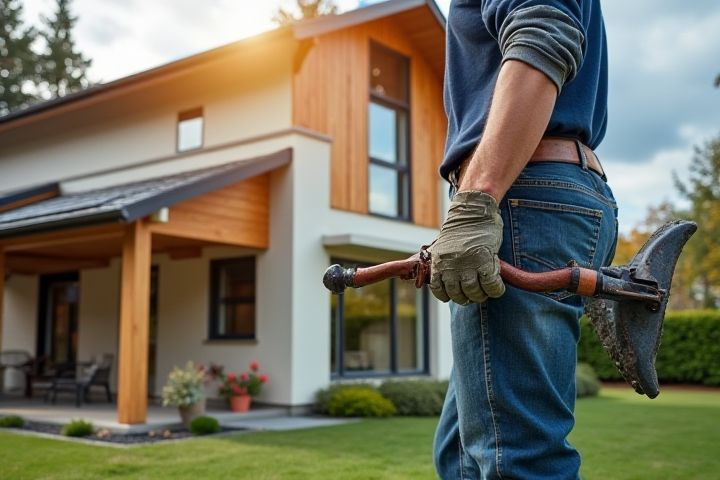
Improving house energy efficiency can significantly reduce your energy bills and environmental footprint. Start by sealing gaps around windows, doors, and ducts to prevent drafts and heat loss. Upgrading to energy-efficient appliances, such as ENERGY STAR-rated refrigerators and washing machines, can lower energy consumption. Installing insulation in attics and walls enhances thermal resistance, keeping your home warmer in winter and cooler in summer. Finally, consider incorporating renewable energy sources, like solar panels, to further minimize reliance on traditional energy sources.
How To Improve House Energy Efficiency
Upgrade to energy-efficient appliances
Upgrading to energy-efficient appliances can significantly reduce your household energy consumption by up to 30%. Look for appliances with the ENERGY STAR label, which indicates that they meet strict efficiency guidelines set by the U.S. Environmental Protection Agency. For instance, replacing an old refrigerator with an ENERGY STAR model can save you approximately $200 annually on your electricity bill. Investing in high-efficiency appliances not only lowers energy costs but also minimizes your carbon footprint, contributing to a more sustainable environment.
Install LED lighting
Installing LED lighting can reduce your energy consumption by up to 80% compared to traditional incandescent bulbs. These long-lasting lights have an average lifespan of 15,000 to 50,000 hours, significantly decreasing replacement costs and waste. By switching to LED bulbs, you not only lower your electricity bills but also minimize your carbon footprint, contributing to a sustainable environment. Furthermore, LED lighting provides better quality illumination, enhancing the ambiance of your home while improving overall energy efficiency.
Seal and insulate windows and doors
Sealing and insulating windows and doors can significantly enhance your home's energy efficiency, potentially reducing heating and cooling costs by up to 25%. Use weatherstripping or caulk to fill gaps around windows and doors, which can prevent air leaks that compromise indoor temperatures. Consider installing energy-efficient window films or double-glazed windows, which can improve insulation by up to 50% compared to single-pane glass. By investing in quality door sweeps, you can further minimize drafts, ensuring a more comfortable living space and reduced energy expenditure.
Use smart thermostats
Smart thermostats can reduce your energy bills by up to 15% by optimizing heating and cooling schedules based on your daily routines. These devices use advanced algorithms and machine learning to analyze temperature patterns and adjust your home's climate automatically. Featuring Wi-Fi connectivity, smart thermostats allow you to control your home's temperature remotely via a smartphone app, ensuring comfort while conserving energy. Investing in a smart thermostat not only enhances your home's energy efficiency but also contributes to a greener environment by reducing overall energy consumption.
Optimize HVAC systems
Investing in a smart thermostat can reduce your HVAC energy consumption by up to 10-15%, allowing you to adjust temperatures based on your schedule. Regular maintenance, such as cleaning or replacing air filters every 1-3 months, can enhance system performance and longevity. Sealing ducts and insulating areas can help reduce energy loss by 20% or more, ensuring that heated or cooled air reaches your living spaces effectively. Consider upgrading to energy-efficient models, which can consume 30-50% less energy compared to older systems, providing both comfort and cost savings.
Add or improve insulation
Improving insulation is a vital step in enhancing your home's energy efficiency, as up to 30% of heating and cooling energy can be lost through poorly insulated walls, roofs, and floors. By adding or upgrading insulation in your attic, walls, and crawl spaces, you can significantly reduce energy bills by preventing heat transfer. The Department of Energy recommends achieving an R-value of 38 for attics and R-13 to R-21 for walls, depending on your climate zone. You can choose from various insulation materials, including fiberglass, cellulose, and spray foam, each offering distinct benefits and efficiency ratings.
Install solar panels
Installing solar panels significantly enhances your home's energy efficiency by harnessing renewable energy from the sun. These photovoltaic systems convert sunlight into electricity, reducing reliance on fossil fuels and lowering utility bills. Additionally, solar panels can increase your home's value and offer potential tax incentives and rebates. By integrating energy storage solutions, you can optimize energy use, ensuring that you have power even during peak demand or outages.
Utilize energy-efficient landscaping
Utilizing energy-efficient landscaping can significantly enhance your home's energy efficiency by strategically placing trees and shrubs. Planting deciduous trees on the south and west sides of your house can provide shade during the hot summer months, potentially reducing your cooling costs by 25%. Incorporating native plants and xeriscaping reduces the need for irrigation, saving approximately 50-75% in water consumption. You can also create windbreaks with evergreen trees to shield your home from cold winds, potentially lowering heating costs by up to 30%.
Implement energy-conscious habits
Implementing energy-conscious habits can significantly enhance your home's energy efficiency. By adopting simple practices such as turning off lights when exiting a room, using power strips for electronic devices, and unplugging chargers when not in use, you can reduce energy consumption by up to 20%. Additionally, utilizing energy-saving appliances, which often feature the ENERGY STAR label, can help lower your energy bills and decrease your carbon footprint. Consider adjusting your thermostat by just 1degF to 2degF; this small change can lead to a 1% reduction in heating and cooling costs for every degree you adjust.
Conduct regular energy audits
Conducting regular energy audits allows homeowners to identify areas where energy is being wasted in their houses. These audits typically involve examining insulation levels, air leaks, and appliances, providing a comprehensive overview of energy use. According to the U.S. Department of Energy, homeowners can reduce heating and cooling costs by up to 30% through these assessments. By addressing inefficiencies, you can significantly lower your utility bills and contribute to a more sustainable environment.
